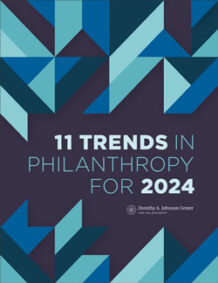Expected Changes to Federal Race and Ethnicity Standards Present Opportunities — and Caveats


 This article was first published in our 11 Trends in Philanthropy for 2024 report. Explore the full report here.
This article was first published in our 11 Trends in Philanthropy for 2024 report. Explore the full report here.
Want the latest trends, research, and more delivered right to your inbox? Subscribe to the Johnson Center email newsletter.
In the summer of 2022, the City Council for Anaheim, California, recognized the efforts of the Arab American Civic Council and the broader Arab American community to formalize that community’s contributions, designating a portion of the downtown “Little Arabia” (San Román). This designation acknowledges a generation’s efforts to build community in the neighborhood and the many years of work from advocates to build a common cause across national identities in order to gain public visibility.
Much like the development of the “Hispanic” identity decades earlier, people from countries including Syria, Libya, Iraq, and Saudi Arabia — alongside those descendant from these countries, born in the United States — have today adopted the MENA* (Middle Eastern or North African) identity (for the construction of the “Hispanic” identity, see Mora, 2014; for the working classification of the MENA category, see Buchanan et al., 2016). The Anaheim City Council member who advanced the proposal to designate Little Arabia said the intent was to recognize “the substantive value of history, culture and place that Little Arabia has for Anaheim. For our city to say, ‘We see you, we’re going to name you and we’re going to be proud to do this’ is critical” (San Román, 2022, para. 20).
MENA advocates in Anaheim and beyond are part of a movement to change the way the U.S. government collects data on race and ethnicity — rethinking the “limits of whiteness,” to borrow the title of a work by scholar Neda Maghbouleh (2017), a study of how Iranian Americans have moved back and forth across the color line. This movement gained momentum in 2023 when the Office of Management and Budget (OMB) proposed new race and ethnicity data collection standards.
MENA advocacy and the OMB’s proposed changes spring from a common problem: millions of Americans do not see themselves in the racial and ethnic categories officially recognized by the U.S. government.
According to the U.S. Census Bureau, people who identify as MENA are counted as white, without ethnic qualification (OMB, 2023). For many, however, this does not reflect their lived experience. As one Iranian American student explained,
[w]hite teachers and counselors have tried to correct me when I claim an ‘other’ racial identity. They say, ‘If you’re Iranian, then you’re white.’ And it’s like, […] ‘Tell me what other ‘white’ countries are sanctioned, exploited, and vilified the way Iran is right now? And am I ‘white’ like you when I’m at the airport? (Maghbouleh, 2017, p. 1).
Like this student, roughly 15% of the U.S. population identified as “some other race” on the 2020 Census. (About 90% of those respondents who selected “some other race,” whether alone or in combination with another race, identified as “Hispanic or Latino” [Jones et al., 2021]). In other words, for about one out of every seven people living in the United States, the provided list of racial categories that respondents could choose from either did not at all or did not fully encompass their identity. This proportion surpassed all but the “white” racial category in 2020 (Jones et al., 2021).
For the first time in a quarter century, the federal government recently proposed new data collection standards. On January 27, 2023, the OMB published and requested comments on its “Initial Proposals for Updating OMB’s Race and Ethnicity Statistical Standards” in the Federal Register. These standards were first established in 1977, in the wake of the civil rights movement. They have not been significantly amended since 1997 when the OMB divided the “Asian or Pacific Islander” category into two distinct groups and began permitting respondents to select more than one race category overall.
The 2020 Census asked residents first to identify their ethnicity (i.e., “Is this person of Hispanic, Latino, or Spanish origin?”) and then to identify their race (Marks & Rios-Vargas, 2021). The OMB’s proposed updates include combining the ethnicity and race questions into a single question and adding a category for people who identify as MENA.
“The OMB’s proposed updates include combining the ethnicity and race questions into a single question and adding a category for people who identify as MENA.”
This proposal has generated advocacy at both the national and state levels. Organizations nationwide are largely urging the OMB to adopt its proposed changes. Groups such as the Arab American Institute (through its outreach initiative, Yalla, Count MENA In!) and the National Network for Arab American Communities, for example, support the addition of a MENA category. Last year also saw a growth in parallel advocacy to bring state agencies up to the proposed federal standards. In this work, the Robert Wood Johnson Foundation (RWJF) — through their fiduciary, the Leadership Conference Education Fund — has established a national network of grantees conducting campaigns in states as varied as California and Michigan.1
The OMB is slated to announce its decision on the proposed changes in summer 2024. Assuming the agency adopts the proposed changes — which seems likely — there are many protocols that nonprofits and foundations may spend the next several years ironing out (in accordance with whatever implementation timeline OMB provides).
First, entire communities will be visible in federal — and, eventually, state — data on everything from public health to policing and incarceration. Those organizations with data-reporting requirements for federal grants will need to adjust their data collection and reporting. Eventually, most nonprofits will need to adjust their data collection as other funders adopt the new guidelines. For instance, RWJF has called for those organizations collecting or reporting on data to “ensure adequate sample sizes of small, disadvantaged groups to permit meaningful analysis, even if it means more financial resources are needed,” as well as to “commit to using disaggregated data to inform policies, practices, and programs” (Braveman et al., 2022, pp. 32–34).
Beyond this, adding categories to federal data creates a new “protected class” of people for civil rights law enforcement. We should expect to see advocacy on behalf of MENA communities, for example, to redraw electoral districts and secure additional rights. Nonprofit organizations and funders should prepare for the implications of these efforts as they consider their roles in correcting longstanding injustices.
Perhaps most importantly, the philanthropic sector will need to help steer the national conversation away from the inevitable backlash to changing race and ethnicity standards. While claims about the disappearance of white people are not new, we should expect these false assertions to resurface in the wake of the OMB’s anticipated decision. (See, for example, Jones, 2022, for the “great replacement” theory and its role in hate crimes.) By refining race and ethnicity data standards, the OMB is simply recognizing the social reality that uncounted numbers of people face every day.
See also, for example, the distinction made between the terms “Hispanic” and “Latino.” For an examination of the development of the Hispanic identity, see Mora, 2014.
_______________
1 The Johnson Center is leading the Michigan-focused campaign, alongside other partners such as ACCESS, with funding from LCEF.


Braveman, P., Arkin, E., Kauh, T., & Holm, N. (2022, May). Health equity: Everyone counts: The need for disaggregated data on marginalized or excluded racial/ethnic groups. University of California, San Francisco, Robert Wood Johnson Foundation. https://www.rwjf.org/en/insights/our-research/2022/05/health-equity–everyone-counts.html
Buchanan, A., Marks, R., & Figueroa, M. A. (2016, September 7). 2015 forum on ethnic groups from the Middle East and North Africa: Meeting summary and main findings. U.S. Census Bureau. https://www.census.gov/content/dam/Census/library/working-papers/2015/demo/MENA-Forum-Summary-and-Appendices.pdf
Jones, D. (2022, May 16). What is the “great replacement” and how is it tied to the Buffalo shooting suspect? NPR. https://www.npr.org/2022/05/16/1099034094/what-is-the-great-replacement-theory
Jones, N., Marks, R., Ramirez, R., Ríos-Vargas, M. (2021, August 12). 2020 Census illuminates racial and ethnic composition of the country. U.S. Census Bureau. https://www.census.gov/library/stories/2021/08/improved-race-ethnicity-measures-reveal-united-states-population-much-more-multiracial.html
Maghbouleh, N. (2017). The limits of whiteness: Iranian Americans and the everyday politics of race. Stanford University Press. https://www.sup.org/books/title/?id=24756
Marks, R., & Rios-Vargas, M. (2021, August 3). Improvements to the 2020 Census race and Hispanic origin questions designs, data processing, and coding procedures. U.S. Census Bureau. https://www.census.gov/newsroom/blogs/random-samplings/2021/08/improvements-to-2020-census-race-hispanic-origin-question-designs.html
Mora, G. C. (2014). Making Hispanics: How activists, bureaucrats, and media constructed a new American. The University of Chicago Press.
Mustafa, L., Naga, E., Garmo, G., & Slimani, Y. (2021, April 21). We are still here: The continued need for SWANA recognition at the University of Michigan. The Michigan Daily. https://www.michigandaily.com/michigan-in-color/we-are-still-here-the-continued-need-for-swana-recognition-at-the-university-of-michigan/
Office of Management and Budget. (2023, January 27). Initial proposals for updating OMB’s race and statistical standards. https://www.federalregister.gov/documents/2023/01/27/2023-01635/initial-proposals-for-updating-ombs-race-and-ethnicity-statistical-standards
OMB Interagency Technical Working Group on Race and Ethnicity Standards. (2023, January 25). History of Statistical Policy Directive No. 15. https://spd15revision.gov/content/spd15revision/en/history.html
San Román, G. (2022, August 26). Anaheim’s ‘Little Arabia’ neighborhood is finally official. Los Angeles Times. https://www.latimes.com/california/story/2022-08-26/little-arabia-is-designated-in-anaheim-after-decades-of-seeking-recognition